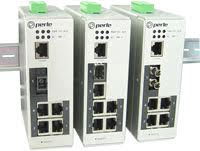Advanced Protocols in Industrial Managed Switches
Optimizing the performance and intelligence of the network
Many times, the implementation of standards based interactive protocols, such as LLDP-Link Layer Discovery Protocol, is what distinguishes Enterprise-grade networks from those implemented by Small to Medium Sized Businesses. These protocols enable end devices, switches and routers in the network to interact and communicate their specific configurations and requirements, thus optimizing the performance and intelligence of the overall network.
The Advanced Protocols discussed below are supported in Perle Industrial Managed Switches with the PRO software feature set.
LLDP
LLDP-Link Layer Discovery Protocol, as per IEEE 802.1AB, is a neighbor discovery protocol that is used for network devices to advertise information about themselves to other devices on the network. This protocol runs over the data-link layer, which allows two systems running different network layer protocols to learn about each other via TLVs (Type-Length-Value)
LLDP Media Endpoint Discovery is an extension to LLDP that operates between endpoint devices such as IP phones and network devices such as switches. It specifically provides support for voice over IP (VoIP) applications and provides additional TLVs for capabilities discovery, network policy, Power over Ethernet, inventory management and location information.
GVRP
Generic Attribute Registration Protocol (GARP) VLAN Registration Protocol (GVRP) is an application defined in the IEEE 802.1Q standard that allows for the control of VLANs. With GVRP, the switch can exchange VLAN configuration information with other GVRP switches, prune unnecessary broadcast and unknown unicast traffic, and dynamically create and manage VLANs on switches that are connected through 802.1Q trunk ports
Voice VLANs
Voice VLANs enables one to separate, prioritize, and authenticate voice traffic moving through your network, and to avoid the possibility of broadcast storms affecting VoIP (Voice-over-IP) operation. With an IP Phone connected to an access port, a Voice VLAN enables the use of one VLAN for voice traffic and another VLAN for data traffic from an Ethernet device attached to the phone.
MSTP – Spanning Tree Protocol
Connecting switches in such a way that a bridge loop is created can create performance degrading broadcast storms. To prevent this, different Spanning Tree protocol standards were developed over the years.
RSTP (IEEE 802.1w) which is interoperable with the original and much slower Spanning Tree Protocol (STP), takes advantage of point-to-point wiring and provides rapid convergence of the spanning tree. Reconfiguration of the spanning tree can occur in less than 1 second.
Originally defined in IEEE 802.1s, and now incorporated into IEEE 802.1Q-2014, MSTP defines an extension to RSTP for use with VLANs. The Multiple Spanning Tree Protocol configures a separate Spanning Tree for each VLAN group and blocks all but one of the possible alternate paths within each Spanning Tree.
Multicast Management
IP Multicast frames are used for communicating between a server and a number of devices at the same time. These types of frames are used in video and industrial applications as an example.
In order to assist in limiting the number of these multicast frames from being propagated around to every device, whether they are part of the target group or not, a number of techniques are exercised by Layer 2 switches
- IPV4 IGMP Snooping : Internet Group Management Protocol (IGMP) constrains the flooding of multicast traffic by dynamically configuring Layer 2 interfaces so that multicast traffic is forwarded to only those interfaces associated with IP multicast devices.
- IPV6 MLD Snooping: With Multicast Listener Discovery (MLD) snooping, IPv6 multicast data is selectively forwarded to a list of ports that want to receive the data, instead of being flooded to all ports in a VLAN. This list is constructed by snooping IPv6 multicast control packets
- GARP Multicast Registration Protocol (GMRP) provides a constrained multicast flooding facility similar to IGMP snooping. GMRP provides a mechanism that allows bridges and end stations to dynamically register group membership information with the MAC bridges attached to the same LAN segment and for that information to be disseminated across all bridges in the Bridged LAN that supports extended filtering services.
